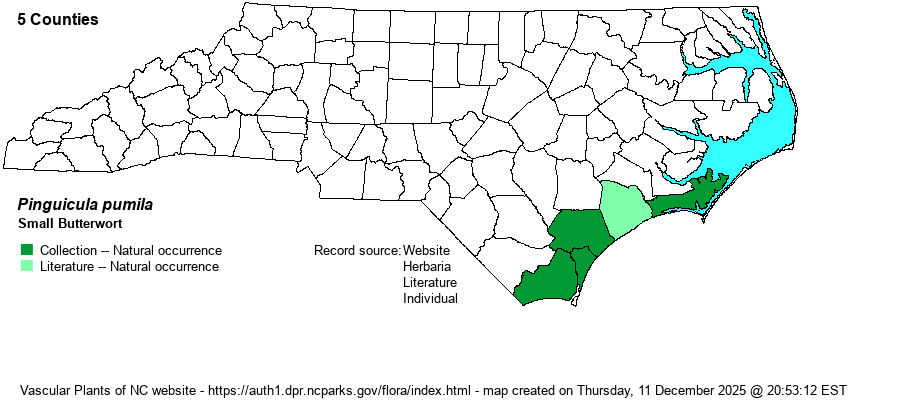| Author | Michaux | |
| Distribution | Restricted in the Coastal Plain only to counties along the Atlantic Coast, from Carteret to Brunswick (a total of five counties). A specimen at UNCC (20353) needs to examined, as without a flower the specimen could simply be a runt individual of another butterwort species. Unlike the other two butterworts, it has not been found in counties inward from coastal counties (unless the Bladen one is confirmed).
This is a species essentially restricted just to the lower Coastal Plain of the Southeastern states, and is not found in the upper Coastal Plain of this area. Thus, it occurs from coastal southeastern NC south to southern FL, and west to eastern TX.
| |
| Abundance | Rare to locally uncommon, with most records from Carteret and Pender Counties. It is a State Threatened species. | |
| Habitat | All three butterworts (Pinguicula spp.) are found primarily in savannas, less so in wet pine flatwoods and in powerline clearings that mimic a savanna. The species is oddly scarce or "missing" from some well known savanna sites, but can be found at a number of places in Holly Shelter Game Land (Pender) and in southern Croatan National Forest (Carteret). |
| Phenology | Blooms mostly in April and May, and fruits shortly after flowering. | |
| Identification | This is the "tiny" member of the three butterwort species in the state. Each leaf in the basal rosette in barely 1/2-inch long or slightly longer, such that the rosette diameter is usually just 1-1.5 inches across, barely the size of a nickel or a quarter. The leaves are widely elliptic and sticky, lying along the ground but with the margins up-curled as in the other butterworts. The flowering stem grows only about 4 inches tall, and is topped by a white to very pale blue flower with cleft petals. The flower is typically about 3/4-inch or less across, much smaller than the other two butterworts. Some individuals can have flowers blue enough to resemble those of the larger P. caerulea, but the latter species has flowers 1-inch across or larger. All three species have a narrow spur on the back of each flower, as in many fringed orchid (Platanthera) species. | |
| Taxonomic Comments | None
| |
| Other Common Name(s) | None | |
| State Rank | S2 | |
| Global Rank | G4 | |
| State Status | T | |
| US Status | | |
| USACE-agcp | OBL link |
| USACE-emp | OBL link |

